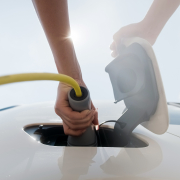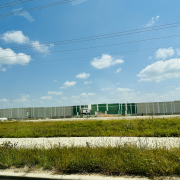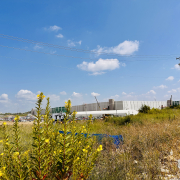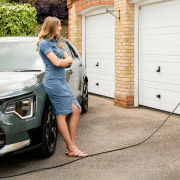By Kasi Darnell, Drew Arends and Layne Stracener
The hum of progress is getting louder on the outskirts of De Soto, Kansas.
Once a quiet town nestled along the Kansas River, De Soto now finds itself at the epicenter of the largest economic development project in Kansas history: Panasonic’s $4 billion electric vehicle battery plant.
Panasonic recently hosted the grand opening of the massive facility. But almost as quickly as the ribbon was cut, the company announced it would delay full-scale production, citing declining electric vehicle (EV) sales and U.S. policies that do not support EVs.
With promises of thousands of jobs, billions in investment and a surge of new residents, De Soto is on the edge of extraordinary change. Yet the central question remains: will this growth be sustainable?
A New Frontier
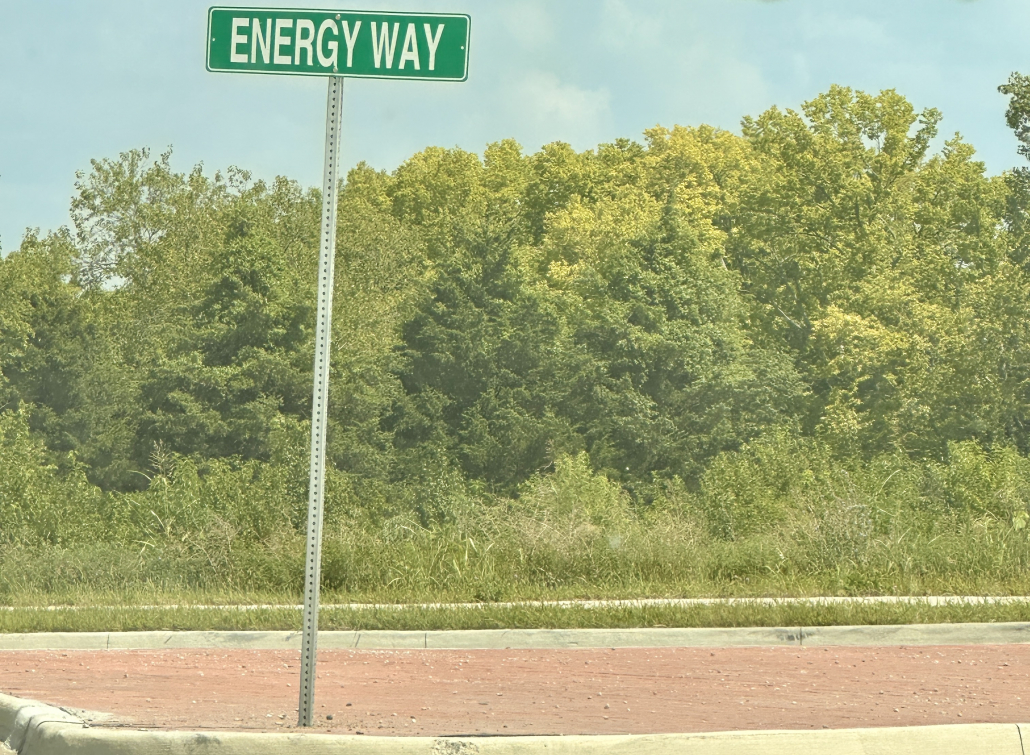
Follow Energy Way straight into the future of De Soto, where innovation meets community.
On the edge of town, the new Astra Enterprise Park facility looms large—literally. When complete, the sprawling plant will cover 300 acres, big enough to fit more than 225 football fields. Panasonic expects the plant to boost its global battery production capacity by 60 percent, making De Soto a key node in the world’s transition to electric vehicles.
City leaders anticipate ripple effects. A $2 million investment in planned road improvements could generate an estimated $400 million in infrastructure, education and community benefits over the next 20 years, according to the City of De Soto’s website.
The challenge is ensuring those benefits are broadly shared—and built to last. The lithium-ion battery plant represents more than local development. It has the potential to transform De Soto’s identity while accelerating the global shift to clean energy.
A Town In Transition
On Main Street, the pace of change is felt in the everyday rhythms of small-town life.
At Cause Coffee, the low hum of conversation mingles with the distant rumble of construction—a fitting soundtrack for a town on the edge of transformation. Repurposed from a historic house, the café has become more than just a place to grab a drink. It’s a central hub where longtime locals and newcomers share space, stories and a cautious optimism about the future.
Some expressed hope. Others voiced concern. But nearly all shared an awareness that De Soto is changing—and quickly.
“I think it’s good,” said one woman who has lived in De Soto for nine years. “But I think it’s going to change our town. What happens to small town life?”
Other residents shared similar apprehension to what the development means for the community, citing the dramatic increase in housing developments, foreign investment and low-paying jobs as downsides to the project.
One small business owner said contracts have been hard for local firms to secure.
“I can’t bid against the unions that have over 5,000 people,” he said. “Yes, some are from the Kansas City area, but there has not been as much investment into the community as was promised.”
Opinions ranged from fears of a “trainwreck” to cautious optimism, but most agreed the outcome could go in many directions.
Just across the street, the transformation of the Johnson County Library De Soto Branch mirrors De Soto’s own. The building closed in September for a remodel and will reopen in spring 2026. It’s a “happy coincidence” that the major update aligns with other developments in town, said Julia Vanderwerff, a clerk who works part-time at the branch.
Vanderwerff cited a noticeable uptick in library cards, with new families coming in and new cards being printed “at least a couple of times a week.” As new families arrive and longtime residents adapt, De Soto’s institutions are rising to meet the moment. It’s a reminder that sustainable growth isn’t only about infrastructure or industry—it’s about people and the public places that bring them together. The library continues to serve as a critical “third space”—a neutral ground where all people, regardless of income, background or how long they’ve lived in town, can feel welcome.
And that’s where the heart of the sustainability question lies. Because growth—no matter how green or well-branded—is only truly sustainable when it accounts for everyone. That means the longtime residents, small business owners, hourly workers and people whose day-to-day lives will be shaped by what’s being built. If development doesn’t reflect their needs and realities, it risks becoming just another missed opportunity.
Promising Growth
The De Soto Chamber of Commerce sees opportunity in the rapid changes.
Tim Holverson, president of the De Soto Chamber of Commerce and Economic Development Council, said the Chamber is enthusiastic about community growth but mindful of the need to “protect, preserve and enhance existing infrastructure along Main Street.” He pointed to an 88 percent increase in sales tax receipts, evidence of rising economic activity and stronger local business performance.
“People are coming because of what is here but also the promise of what’s coming.” Holverson said.
The Chamber is actively recruiting new businesses and industries to De Soto.

New apartment construction near Astra Enterprise Park as De Soto experiences rapid development.
“There’s one I would love to tell you about,” Holverson teased, hinting at future announcements.
Still, Holverson acknowledged that rapid growth comes with challenges. Astra Enterprise Park, once the site of an ammunition factory, has required extensive remediation to prepare for redevelopment. Housing is a particular pressure point. With a vacancy rate of just 1.6 percent— “stupidly, ridiculously low,” as Holverson puts it—the city faces a crunch. While thousands of apartments and single-family homes are under construction, concerns remain about affordability and the risk of rising property taxes pushing out longtime residents.
This summer, Panasonic surpassed its hiring goal of 1,000 employees by about 100. A massive solar farm is slated for development nearby, and the city’s water treatment facility has been upgraded to an 8-million-gallon capacity.
Whether welcomed or met with concern, growth is inevitable. The question is how—and whether—it will be sustainable.
Growth at Astra Enterprise Park
Panasonic officials said they believe Astra Enterprise Park can deliver immense economic benefits—and do so sustainably. The company has pledged to source 100 percent local renewable energy for Astra Enterprise Park within 10 years and reduce environmental impact across its supply chain.
“As a producer of automotive batteries for EVs, Panasonic has a responsibility to be a pioneer in the fight against climate change,” an article on Panasonic’s website states.
But sustainability is more than just corporate commitments or kilowatt-hours saved. It’s whether families can afford to stay in their homes. It’s whether small businesses can thrive alongside global corporations. It’s whether development builds resilience—social, economic and environmental—for generations to come.
What’s Next?
At Metropolitan Energy Center (MEC), we believe growth can be sustainable if planned intentionally. For more than 40 years, MEC has worked at the intersection of energy, community health and economic vitality.
In places like De Soto, sustainable development means planning for homes that are not only affordable but also energy efficient. It means EV-ready infrastructure and clean transportation options that reduce pollution. It means retrofitting existing structures, supporting workforce development in the trades and ensuring longtime benefits for residents—not just newcomers or corporations.
MEC believes the City of De Soto and Panasonic have a unique opportunity to showcase what sustainability in a new frontier can look like. Imagine a city where new buildings are equipped with solar panels and heat pumps, weatherization features are built into every home and multi-modal transportation options help preserve the peaceful charm of a quiet river town without the disruption of excess traffic.
For Panasonic, picture a solar farm powering its massive infrastructure (which is in the works), a robust rideshare program bussing Kansas City-area employees to and from De Soto and electric vehicle chargers installed right outside the EV battery plant.
These ideas aren’t pipe dreams—they are tangible realities. As De Soto grows, we contend it has a responsibility to the community it serves to make sustainability a central part of its future.
As the Panasonic project advances, we’re here to support efforts that prioritize local workforce development, energy benchmarking and climate-smart growth policies—because sustainability isn’t just about new technology. It’s about people, systems and values.
MEC is home to a range of impactful programs—Building Performance, Energy Solutions Hub, Sustainable Transportation and Clean Cities—all of which have helped communities across Kansas and Missouri make the shift toward a more sustainable future—quietly, strategically and with long-term vision.
At MEC, we’re ready to be part of the conversation, offering tools, partnerships and perspective for a future that honors the past while building something smarter.
De Soto’s story is unfolding in real time—a crossroads of rural identity, economic ambition and environmental responsibility. As this small town takes a big leap, let’s make certain it lands on solid, sustainable ground.
Want to bring sustainability into your growing community? Connect with us at metroenergy.org or reach out to learn how MEC can support your city’s future. Contact Kasi, Drew, or Layne to learn more.
written by MEC Clean Cities intern Drew Arends
In the past year or so, there has been a multitude of funding opportunities released to promote electric vehicle infrastructure. While some of this funding has been automatically allocated to state governments, the rest of it is available through a competitive grant application process. With so much funding available, the “how” in obtaining this funding can be difficult for the everyday person. With sales of electric vehicles surpassing one billion dollars to date, there is no better time to shed light on how federal funding can be achieved, especially for those in the heart of the Midwest.
At Metropolitan Energy Center (MEC), a portion of the services we provide include consultations and grant writing services for anyone looking to find financial support for alternative fuel and energy efficiency projects. In this post, I will outline some helpful tips to find grants and three particular grants available for Missourians and Kansans.
Climate Program Portal is one central location for key funding opportunities and developments related to large pieces of federal legislation, most notably the Infrastructure Investment and Jobs Act (IIJA) and the Inflation Reduction Act (IRA). By enrolling in a free membership, you can have access to the details and deadlines behind various projects. When you become a member, the dashboard part of the site provides you with the most important information. For instance, as of (date of publication), there are 44 different requests for proposals (RFPs), requests for information (RFIs), and notices of intent (NOIs). These calls stem from a wide range of organizations, with the leaders being the Department of Energy (DOE) and the Environmental Protection Agency (EPA), but closely followed by state agencies and the Department of Transportation (DOT). Further along the dashboard, you can find the specific details of each proposal, with links for more information providing additional insight under the “source” column.
Currently, some of the biggest opportunities for Missourians and Kansans include the FRE, CRP, and the Charging and Fueling Infrastructure Discretionary Grants programs.
Freight Enhancement Program (FRE)
The FRE program is open to public and private entities to construct non-roadway projects to improve freight efficiency in Missouri. All project awards are subject to approval of the $3.25m included in the legislative budget (HB4) that is signed by Gov. Parson. Applications are due by 5p.m. May 19, 2023. Projects must be completed and billed to MoDOT by 6/15/2024.
A Call for Projects for the Carbon Reduction Program (CRP)
Mid-America Regional Council is soliciting project proposals for the Federal Highway Administration’s Carbon Reduction Program (CRP) for Federal Fiscal Years 2022-2024. Eligible Applicants include local governments, transportation agencies and non-profits located within MARC’s MPO Boundary (Johnson, Leavenworth, Miami and Wyandotte counties in Kansas, and Cass, Clay, Jackson and Platte counties in Missouri. MARC is providing office hours April 19, May 9 & 15 to answer any questions you may have. Project Applications are due May 19.
Charging and Fueling Infrastructure Discretionary Grant Program
This program is divided into two categories: Community Programs and Corridor Programs. The Community Programs category is more of a general group meant to provide funding for projects along parks, schools, roads, and parking lots, while the Corridor Programs are meant to assist with more complex projects along designated alternative fuel corridors. The total amount available for recipients is around $700 million (FY 2022 $300 million and FY 2023 $400 million) and one of those recipients could be a Missourian or Kansan like you! Eligible applicants include states or political subdivisions of states; metropolitan planning organizations; units of local governments; special purpose districts or public authorities with a transportation function, including port authorities; Indian tribes; U.S. territories; and authorities, agencies, or instrumentalities or entities owned by one or more entities listed above. Applications must be submitted electronically through grants.gov no later than 11:59 p.m., eastern time, on Tuesday, May 30, 2023. Applicants are encouraged to submit applications before the deadline, set up an account and regularly monitor for updates.
——
These are merely three examples of the many funding opportunities currently available. Representing various entities like nonprofits, local groups, state governments, and community-based organizations, they are a raindrop in the ocean compared to the numerous funding opportunities out there. As such, I recommend that for whatever reason you are seeking funding, you not only consult databases like Climate Program Portal, but the federal websites of places like the DOE, EPA, and DOT. Help is most definitely here, and it is the pleasure of those of us at MEC to help you find what you’re looking for. Our bi-weekly newsletter consistently provides you with information regarding funding, and our social media accounts (Twitter @KCCleanCities and @MetroEnergyKC; Instagram @metroenergykc ; Facebook @MetropolitanEnergyCenter) supply real-time updates. Of course, our services with grant writing and consultations go beyond these briefs and give you the opportunity to work alongside us.
With the right insight and partnership, your idea could be the next recipient of funding to advance sustainability efforts in your own community! For more information regarding ongoing funding opportunities, check out this page for follow-up blog posts, and sign up for our Clean Cities newsletter to follow all relevant updates and new funding opportunities.
——
Author Bio: Drew Arends has been a Sustainable Transportation Intern at Metropolitan Energy Center since November 2022. His primary efforts have involved newsletter production, campaign development, and community outreach. In his work, he has encountered several instances of funding opportunities, a few of which are highlighted in this blog piece. As Drew studies abroad for the next few months, he looks forward to contributing to the efforts of MEC through blog posts like these.
written by MEC Greater Kansas Clean Cities coordinator Jenna Znamenak
This article chronicles recent efforts by Metropolitan Energy Center (MEC) and its Clean Cities Coalitions to make electric vehicle operations a reality in areas that are often left out of new connectivity trends.
To a person who has always lived in a highly populated city, connectivity is a daily reality. Cities get the fastest internet, the most cell coverage, and more nicely paved trafficways. But for the 20% of the population of the United States who live in rural areas, equal connectivity has never been the norm.
As reported in the January/February issue of the Kansas Government Journal by Mike Scanlon, City Manager of Osawatomie, Kansas, “It is no secret that rural communities are historically left behind when the United States adopts the latest technology.” And in recent months, more rural leaders are seeing a potential pitfall that could widen the access gap for their communities: the advancement of electric vehicles (EVs).
As the latest consumer-use scenarios are analyzed and early-adopter reviews roll in, the reality is clear: EVs cost less money to fuel and to maintain than their gasoline-fueled counterparts. And with the recent monumental increases in grants and tax incentives for EV purchases, governments are becoming much more interested in EV funding pipelines than they are in vehicles fueled by oil pipelines. But urban and suburban governments are making the switch much faster than rural governments.
Scanlon is not surprised, but he is hopeful that this time rural America can keep up with the trend. “By 2030 the federal government proposed that half of all new cars sold in the U.S. will be zero-emission vehicles, with 50,000 electric charging networks. By proactively supporting rural EV development now, we can prevent history from repeating itself.” His article in the Kansas Government Journal, co-written with MEC’s Central Kansas Clean Cities Coalition coordinator Jenna Znamenak, prepares rural leaders with real facts and funding connections so they can stay in the fight to stay connected.
The most exciting grants on the list are the ones that get rid of nitrous-oxide-producing diesel school buses by helping school districts convert to EVs, for little to no cost to the schools. “These grants replace older school buses with electric school buses to reduce harmful emissions around children,” says Central Kansas Clean Cities coordinator Jenna Znamenak. But she says there are enough programs available through MEC’s grant assistance to help more institutions than just schools involved with the national sea-change.
For many rural leaders, adapting to standardizing trends sounds like “small budgets with not much room for experimentation, time constraints that do not allow us the ability to learn about technology, and grant opportunities that can look like a 10-acre corn maze,” says Scanlon. “That’s why we’re here for you—we’ve helped connect local communities and fleets to easier funding for clean energy for the past 40 years,” says Znamenak, referring to MEC’s stockpile of resource-accessing tricks and their dependable grant assistance services.
See the original article published in the Kansas Government Journal here.
To stay current on all available funding, sign up for MEC’s free newsletter at metroenergy.org/newsletter-sign-up. To talk to an expert about your next clean energy project, call 816-531-7283.
About Us
Metropolitan Energy Center (MEC) is a 501(c)(3) nonprofit organization. Our mission is to create resource efficiency, environmental health, and economic vitality in the Kansas City region – and beyond. Learn more about us and our programs.

